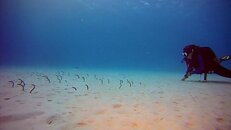Back the truck up to the shore (watch out for that squishy sand and rental trucks) suit up, watch your step as you get in, swim out to the buoy. Drop down and see which way the soft corals are bent, then go over the wall to your preferred depth. Swim into the current until 1/2 a tank then cruise the current back home at the upper edge of the wall until you find the buoy again (sometimes). Work the shallow sand back to shore to burn up the end of your tank and have a nice 10 minute safety stop at the same time (the shallows are mostly 20' or less). Pop up and find your truck and if you miss, you can get out and walk, or just drop back down to the sand and swim a bit.
Great suggestions in the rest of your post. I'd just like to add that there's no need to waste time and energy swimming on the surface to the mooring buoy before descending. In fact many of the best shore dives on Bonaire don't have mooring buoys at all (Taylor Made, Candyland, Petri's Pillar, Salt Pier, Aquarius, Larry's Lair, The Rock, Red Beryl, etc.) or the mooring buoys are located up-shore or down-shore from the shore entry (Jeff Davis Memorial, Weber's Joy, Andrea 1, The Lake, etc.)
With an inexpensive dive compass ($30 to $60) and the dead-reckoning navigation skills learned during your OW certification you can enjoy the dive out and back without missing any of the cool stuff in the shallows. It also mitigates the need to pop up and down to find your truck or exit point at the end. If your compass navigation skills are a little rusty you can practice on the sites with buoys for reference. For the sites without buoys just pick a point on the horizon at a right angle to shore entry, set your heading, and dive out there. On most sites without buoys you'll find dead coral piles or similar impromptu markers left by previous divers to help you find your drop-off point on the return. It's also relatively easy to find unique coral heads, sponges, or other natural markers near the point where you drop over the reef. My preference is to locate a combination of markers (e.g. coral head with soft coral tree on it at 25' with large brown vase sponge at 30'.) I always look behind me at my "marker" when swimming away from it, so I'll know what it looks like on the return. On the return I find my marker, turn towards shore, and follow a compass heading 180 degrees from the original back to my entry point.
I've seen many wonderful small critters during these shallow dives over sand flats over the years. Some examples include garden eels, octopus in small coral heads, and seahorses hanging on to whatever they can. Last year we saw a small pink frogfish in 11' of water near the entrance to Tori's Reef.





